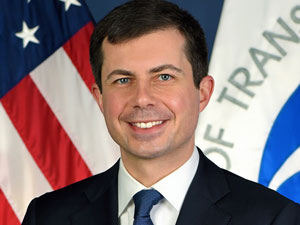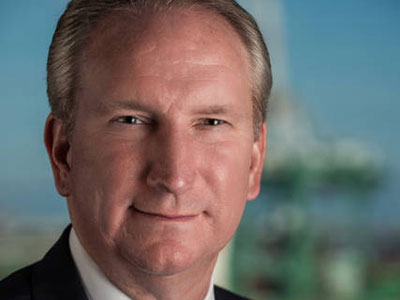Transportation Secretary Pete Buttigieg says that he supports an increase in federal funding for so-called ‘Marine Highway’ vessels to shift port containers off highways and on to the nation’s waterways.
Buttigieg was speaking at a Port of Los Angeles media briefing on November 16th along with the Port’s executive director Gene Seroka.
“Yes, we support it and we’re doing it thanks to this legislation (the Biden administration infrastructure allocation). The Marine Highway program is something I look forward to communicating more to the public about because it is not clearly understood.”
Buttigieg called the potential “huge” for moving truck and containerloads off highways and onto waterways via tug/barges and coastal ships to relieve congestion: “If you think about the potential from a pollution perspective and moving more cargo by the waterways … inland, the potential is huge.”
Currently, in the United States, moving containers by barge and coastal ships is “underutilized,” he said: “We’re excited to take things to the next level because we do think the potential for our waterways to get freight off our roads and reduce emissions is underutilized.”
Buttigieg added “We should be doing more and will be.”

The new infrastructure act will add some additional funding for grants to operate container and freight on barge service:
“In the next 45 days, as per the Biden-Harris Action Plan, we will be announcing the next round of grants, which should be for around $13 million and the infrastructure bill provides an additional $25 million.”
Buttigieg was also asked about the adequacy of federal funding for ports citing an American Association of Port Authorities projection that an additional $70 billion is needed to upgrade U.S. ports.
Buttigieg conceded that more funding is needed but cited the need for public/private partnerships to help provide additional investments for ports.
He added that the “transformational” impact of the Biden infrastructure bill would help upgrade transportation systems and create a “multiplier effect” that would help leverage the long-term cost of upgrading both large and small ports.
Sweeper Ships
Seroka was asked about progress with his efforts to encourage ocean carriers to deploy more so-called ‘sweeper ships’ to help move the backlog of empty containers clogging the Port onto ships for transport back to Asia.

Seroka explained that reducing the backlog of empty containers back to Asia was a process:
“We get 350,000 empty containers that get repositioned back to Asia every month from the Port of Los Angeles. That’s about 90,000 a week. We’re up about 30% from that repo figure of just last year. We’re also receiving empty containers from non-traditional geographies by rail…think of the South Atlantic and Gulf Coast areas. So, we’ve got to double our efforts to get those assets out and back to Asia for the next round of imports.”
However, the Port of Los Angeles has been processing an average of 900,000 containers per month for the last 15 months. Previously, 900, 000 containers corresponded to one month’s volume during the Port’s peak season, but as imports have surged in 2020 and 2021, this is no longer the case.
Seroka said the recent imposition of surcharges on containers dwelling at the docks for over 9 days by the Ports of Los Angeles and Long Beach has resulted in a significant reduction of those long-time dwelling containers.
On November 15th, the Port of Long Beach and Port of Los Angeles announced that they will delay the “Container Dwell Fee” directed at ocean carriers until Nov. 22.
Since the fee was announced on October, 25th, the twin ports have seen a decline of 26% combined in aging cargo on the docks. This development supported a delay in implementation of the fee, the Ports said.
The traffic jam of ships waiting to unload at the Ports of Los Angeles and Long Beach keeps the pressure on marine terminals and longshore workers to unload and move imported containers out of the Port and then reload as many empty containers onto the unloaded ships before they sail back to Asia.
Seroka said efforts to bring in additional container sweeper ships is “encouraging but there is a lot more to do. We’ve seen six additional sweeper ships pick up a little more than 17,000 teus (twenty-foot units) of empties and there are another two ships on the way that can pick up 2,500 teus more empty container units. We’ve got to do a lot more than that.”

